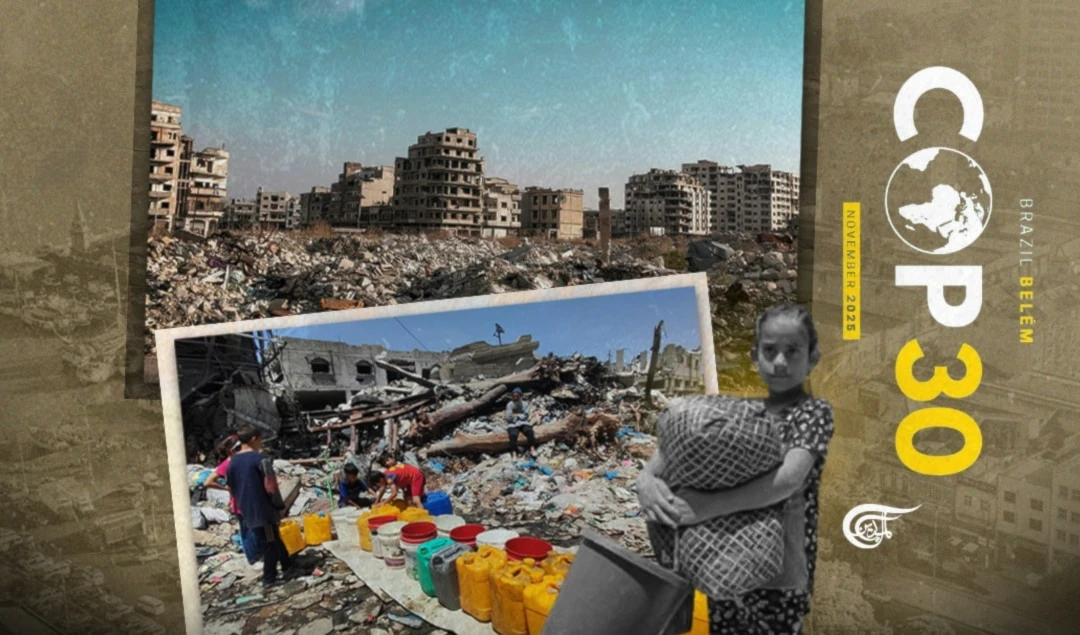A Coherent Regional Approach: Two Years That Rewired the Middle East
Two years after Al-Aqsa Flood, Gaza endures, Hezbollah adapts, and Iran stands firm as Trump’s plan tests a region trapped between war and uneasy pauses.
-

Barring an unforeseen break, the trajectory will persist until one camp secures a strategic victory (Illustrated by Mahdi Rteil to Al Mayadeen English)
Two years on from Operation Al-Aqsa Flood (7 October 2023), which detonated the current Gaza war, the region has undergone convulsions that continue to reverberate. The year since the assassination of Hezbollah’s Secretary-General Sayyed Hassan Nasrallah (27 September 2024) has been especially consequential, not least for the movement’s internal recalibration and for the balance within the wider Axis of Resistance. The landscape has shifted again in 2025 with a 12-day “Israel”–Iran war in June, and, most recently, President Donald Trump’s twenty-point initiative that aims to end the Gaza war through staged withdrawals and a large hostage-prisoner exchange.
After Nasrallah: Shock, Adaptation, and Strategic Intent
The targeting of Sayyed Nasrallah, long the axis’s most recognizable strategist and public voice, was designed to fracture Hezbollah’s command system and political confidence. That did not occur. The party’s doctrinal resilience, deep bench of senior cadres, and external anchor in Iran enabled it to absorb the shock and re-constitute command channels, while keeping its operational tempo deliberately opaque. The assassination also forced a political reset inside Lebanon, where Hezbollah has signaled recovery without telegraphing the pace or shape of its military reorganization.
What the Axis Is, and Is Not
Despite frequent caricature, the “Axis of Resistance” is not a single, centralized operations room. It is a strategic alignment among movements and states that read the Israeli–American project as the primary regional threat and source of instability. The alignment’s logic has hardened in the wake of the Abraham Accords (2020) and continuing talk in Israeli and US politics of “reshaping the Middle East,” a motif that periodically reappears in official rhetoric.
The June 2025 “Israel”–Iran War: A Fragile Pause
The twelve-day confrontation in June 2025 did not achieve regime change in Iran nor eliminate its core programs, but it raised the ceiling of direct engagement and expanded the geography of risk. The fighting ended without a formal ceasefire and with only an informal pause, leaving miscalculation highly likely absent robust de-escalation channels. Any subsequent “de-confliction packages” should be read, at best, as temporary palliatives.
Gaza: Trump’s Plan Meets Hamas’s Calculus
Washington’s latest initiative, a 20-point plan combining a large-scale hostage–prisoner exchange with phased Israeli withdrawals inside Gaza, has moved negotiations into a new phase. Reporting indicates Hamas has signaled conditional acceptance of core elements (exchange plus staged withdrawal), while refusing others, such as measures amounting to external tutelage over Gaza or pre-agreed disarmament without a broader political settlement. “Israel” has publicly tied any deal to the disarmament of Hamas, with talks shuttling through Cairo.
Operationally, “Israeli” captives have become a tactical burden for the Izz al-Din al-Qassam Brigades in protracted urban fighting; conversely, their survival is a political imperative for “Israel”. Completing an exchange now serves two aims for the resistance: (1) securing the maximum release of Palestinian prisoners while leverage remains highest; and (2) reducing pressure on combat units to re-task for any renewed campaign.
For “Israel”, a staged withdrawal that stabilizes lines and returns captives would be presented as a strategic reset pending whatever governance formula emerges for “the day after.”
Where Is the "Flood" Heading?
To call Al-Aqsa Flood a “strategic earthquake” is to view it as a process rather than an episode. Israeli Prime Ministerial rhetoric about “changing the Middle East” sits alongside an operational reality: “Israel” has not secured decisive outcomes in Gaza or Lebanon, even after extensive campaigns, leadership decapitations, and escalatory gambits. Three countervailing facts explain the stalemate so far:
⁃ Gaza’s endurance, militarily and societally, amid unprecedented destruction, coupled with Hamas’s political agility at the table;
⁃ Hezbollah’s shock-absorption and gradual recovery after September 2024;
⁃ Iran’s cohesion and its weathering of the June war without conceding strategic essentials.
“Israel’s” principal constraint is visible in the compulsory path now imposed by the conflict’s dynamics: it can continue to apply pressure at significant human and material cost, but cannot yet reach the threshold of decisive transformation required to lock in a “new Middle East.” The same constraint applies to external sponsors when diplomatic frameworks are used to launder military stalemates into political “resets.”
Necessary Conclusion
We are not at “the end of beginnings” but at “the beginning of endings.” Barring an unforeseen break, the trajectory will persist until one camp secures a strategic victory. The outcome turns on whether the axis can convert attrition plus political maneuver into cumulative advantage, and on whether the “Israeli”–American project can impose a durable post-war architecture, rather than episodic pauses, in Gaza and beyond. The weeks ahead, hostage exchanges, line stabilization inside Gaza, and any follow-on track with Lebanon, will test that proposition.

 Amro Allan
Amro Allan
 5 Min Read
5 Min Read











